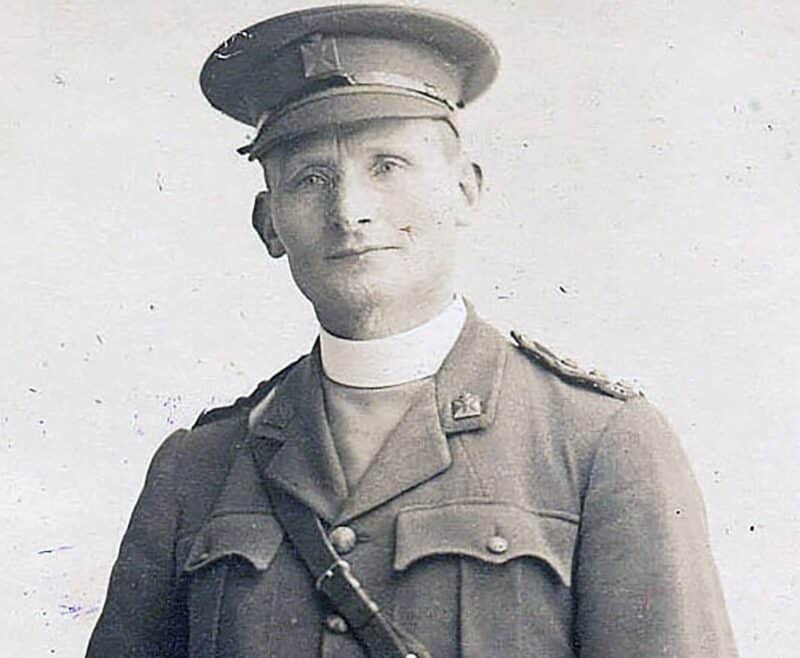According to the entry titled “Catholic Church” in Te Ara: The Encyclopaedia of New Zealand, “New Zealand Catholics went to war with enthusiasm in 1914. Archbishop Redwood regarded the First World War as a battle for justice and civilisation. Catholics were proud of their high rate of volunteering for military service. When conscription was introduced in 1916, the Catholic hierarchy approved it. The Bishop of Auckland, Henry Cleary, served as a military chaplain in the trenches of Flanders, and won a mention in dispatches.”
(Nicholas Reid, in his book “The Bishop’s Paper”, stated that Cleary edited the New Zealand Tablet from 1898 to 1910. Reid wrote: “Later critics of Cleary . . . were to accuse him of pandering to British jingoism, so it is worth noting that through the columns of The Tablet, Cleary opposed New Zealand’s involvement in the Boer War.”)
Reid also noted that, “despite Cleary’s ill health, he volunteered for service as a front-line chaplain in the war in Europe”. His three months of service at the front with the New Zealand 2nd Brigade in France near Fromelles (December, 1916 to February, 1917) damaged his health even further. “’Trench mouth’ led to the loss of all his teeth.” Reid added that, “together with the assistance he gave Auckland city authorities during the great influenza epidemic, his wartime service led to his being awarded the OBE in June, 1919”.
A New Zealand Herald article in 2012 recounted how soldiers’ bodies and many wounded were left in no-man’s-land in Flanders.
“Although a temporary truce had been made with the Germans to allow the wounded to be rescued, it was vetoed by senior officers, and the New Zealand troops were deeply troubled by their inability to recover and bury their comrades,” the Herald article stated.
“Bishop Cleary and an officer crawled out and lay in the snow amid the remains of the dead.” This was whilst being aware that Germans used to shoot burial parties.
“Just 50 metres from the enemy line,” the Herald article continued, “he [Bishop Cleary] said a ‘De Profundis’ over the bodies”.
“However, Bishop Cleary’s wooden crucifix was badly damaged while he was in the trenches, so the Kiwi soldiers gathered up spent shell cases and cobbled together a new crucifix for him.” That crucifix is now in the Catholic Diocese of Auckland archives.
The Te Ara article stated that the “wider Catholic population felt that its sacrifice, shown by the faces of its dead sons in each issue of The Tablet, deserved the gratitude of the rest of the country. Instead, it found itself gradually being made a scapegoat by a war-weary nation. Catholic leaders were accused of using the war to push their religious interests. The Pope’s neutrality and his suspected pro-German sentiments were criticised. Worst of all, the 1916 Easter Rising in Ireland meant that New Zealand Catholics were accused of disloyalty. From 1917, the Protestant Political Association (PPA) carried out a virulent anti-Catholic campaign. It found many willing followers and, after the war, convinced Parliament to pass a number of laws penalising Catholic interests”.
Reid wrote that “across the Tasman, Catholic involvement in the defeat of conscription in Australia in 1916 and 1917, and the anti-imperial sentiments of Archbishop Daniel Mannix of Melbourne, had encouraged a widespread Protestant belief in the ‘disloyalty’ of Catholics to the British Empire. Although there was no conscription referendum in New Zealand, these sentiments flourished here too, despite the fact that Catholics were serving in the Armed Forces in numbers at least proportionate to their numbers in the general population”.
Reid quoted H.S. Moores as stating that “Cleary’s return to New Zealand in 1917 brought a noticeable lift to the confidence of many Catholics. It was Cleary, above all, who could break down the sense of isolation that many Catholics had come to feel during 1917. The bishop was a man liked and respected, even loved, far beyond the confines of his own Church”.
Reid added that, after Cleary’s death, “Pat Lawlor described him as ‘a small Leonardo da Vinci
. . . A brilliant writer and controversialist, an author of books, an editor and a journalist; he was a great business man, a skilled conjuror, an amateur mechanic . . . A motorist of sometimes amazing speed, an amateur aviator, a chaplain in the war and — a Bishop’”.

Reader Interactions